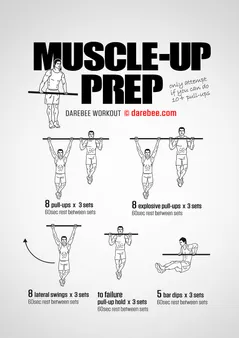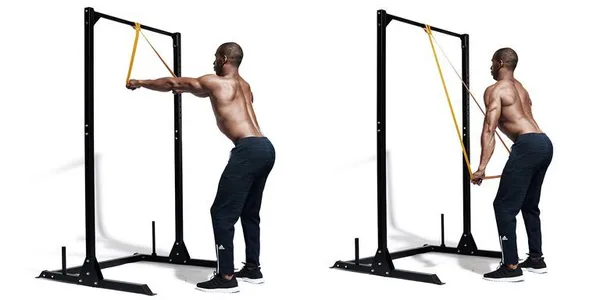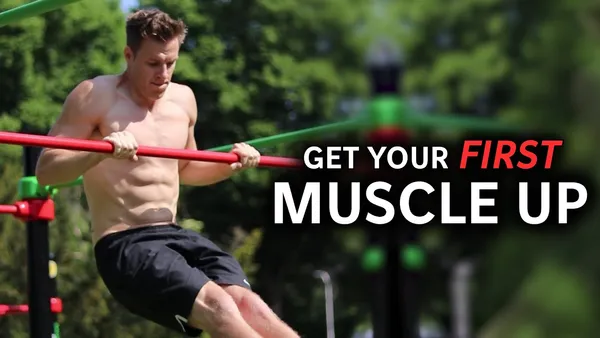Table of Contents
Welcome to Kizworld's ultimate guide to mastering the muscle-up, an impressive feat of strength and agility. This dynamic exercise combines a pull-up and a dip, challenging your upper body muscles like never before. Whether you're a seasoned athlete or just starting your fitness journey, our comprehensive guide will take you through the steps of learning How to do a muscle-up safely and effectively. Discover the benefits of this exercise, learn the proper technique, and overcome common mistakes. Prepare to elevate your fitness routine and achieve new heights with kizworld as your guide.
How to Do a Muscle-Up: Master This Calisthenics Skill
I. Mastering the Art of Muscle-Ups: A Comprehensive Guide
Mastering the Art of Muscle-Ups: A Comprehensive Guide
Benefits of Muscle-Ups
- Increased upper body strength
- Improved coordination and agility
- Enhanced core stability
- Reduced risk of injury
- Boosted self-confidence
How to Do a Muscle-Up
Step 1: Master the Pull-Up
Learn how to do a pull-up with proper form.
Step 2: Practice the Dip
Master the dip exercise to strengthen your triceps and chest.
Step 3: Combine the Pull-Up and Dip
- Start with a pull-up.
- As you reach the top of the pull-up, transition into a dip.
- Lower yourself back down to the starting position.
- Repeat steps 1-3 until you can perform multiple muscle-ups in a row.
Tips for Doing Muscle-Ups
Tip 1: Start with Assisted Muscle-Ups
Use a resistance band or spotter to help you perform muscle-ups until you can do them unassisted.
Tip 2: Focus on Building Strength
Incorporate strength-building exercises into your routine to increase your upper body strength.
Tip 3: Practice Regularly
Practice muscle-ups regularly to improve your technique and strength.
Common Mistakes to Avoid
Mistake 1: Not Warming Up Properly
Warm up properly before attempting muscle-ups to reduce the risk of injury.
Mistake 2: Trying to Do Muscle-Ups Too Soon
Gradually progress to muscle-ups by first mastering the pull-up and dip.
Mistake 3: Not Using Proper Form
Use proper form when performing muscle-ups to avoid injury and maximize results.
Variations of Muscle-Ups
Variation 1: Bar Muscle-Up
Perform a muscle-up on a horizontal bar.
Variation 2: Ring Muscle-Up
Use gymnastic rings instead of a bar.
Variation 3: Weighted Muscle-Up
Add weight to your body to increase the difficulty of the exercise.
Conclusion
With dedication and practice, you can master the muscle-up and enjoy the many benefits it offers. Remember to start slowly, focus on building strength, and use proper form to avoid injury. As you progress, you can try different variations of the muscle-up to challenge yourself and continue improving your skills.
II. Breaking Down the Movement: A Step-by-Step Approach
Breaking Down the Movement: A Step-by-Step Approach
Step 1: Master the Pull-Up
Begin by focusing on mastering the pull-up. This exercise targets the muscles used in the muscle-up, including the lats, biceps, and forearms. Start with assisted pull-ups if necessary, using a resistance band or machine to help you lift your body. Gradually reduce the assistance as you build strength.
- Start with assisted pull-ups if needed.
- Gradually reduce assistance as you build strength.
- Focus on engaging your lats, biceps, and forearms.
How to Do a Pull-Up: Technique, Benefits, and Variations
Step 2: Practice the Dip
Next, work on the dip, which targets the triceps, chest, and shoulders. Start with bodyweight dips on parallel bars. If this is too challenging, use a dip machine or resistance bands for assistance. Aim for sets of 8-12 repetitions.
- Start with bodyweight dips on parallel bars.
- Use a dip machine or resistance bands for assistance if needed.
- Aim for sets of 8-12 repetitions.
How to Do a Dip: Technique, Benefits, and Variations
Step 3: Combine the Pull-Up and Dip
Once you have mastered the pull-up and dip, it's time to combine them into the muscle-up. Start by performing a pull-up, then transition smoothly into a dip. As you gain strength and coordination, you'll be able to perform the muscle-up in one fluid motion.
- Start by performing a pull-up.
- Transition smoothly into a dip.
- Aim for sets of 3-5 repetitions.
How to Do a Muscle-Up: Technique, Benefits, and Variations
III. Conquering Muscle-Ups: Essential Tips and Techniques
Conquering Muscle-Ups: Essential Tips and Techniques
Master the Basics:
- Start with Pull-Ups and Dips: Build a solid foundation by mastering pull-ups and dips. These exercises target the muscles needed for muscle-ups.
- Develop Upper Body Strength: Engage in exercises like bench press, overhead press, and rows to strengthen your chest, shoulders, and back.
Visit our guide on How to Do a Pull-Up for proper technique and variations.
Transition to Assisted Muscle-Ups:
- Use Resistance Bands: Attach a resistance band to the bar and step on it to reduce your body weight, making the muscle-up easier.
- Partner Assisted Muscle-Ups: Have a partner support your feet or hips, providing assistance during the transition phase.
Check out our article on How to Do a Dip for detailed instructions and variations.
Perfect Your Technique:
- Explosive Pull: Initiate the muscle-up with a powerful pull-up, engaging your lats and biceps.
- Smooth Transition: As you reach the top of the pull-up, quickly shift your weight forward and extend your arms to transition into the dip.
- Controlled Dip: Lower yourself slowly and controlled through the dip, engaging your triceps and chest.
Our comprehensive guide on The Benefits of Gymnastics for Kids highlights the advantages of gymnastics for children's physical and mental development.
Common Mistakes to Avoid:
- Rushing the Movement: Take your time and focus on each phase of the muscle-up, avoiding rushing through the transition.
- Incorrect Grip: Ensure your grip is shoulder-width apart and your hands are facing forward to maintain stability.
- Lack of Core Engagement: Keep your core engaged throughout the movement to maintain proper body alignment.
Discover The Best Gymnastics Equipment for Home Use to set up your own home gym and practice gymnastics skills safely.
Variations for Advanced Athletes:
- Weighted Muscle-Ups: Add weight to your body using a weight vest or dumbbell to increase the challenge.
- Ring Muscle-Ups: Perform muscle-ups on gymnastic rings, requiring greater stability and coordination.
- Bar Muscle-Ups: Execute muscle-ups on a traditional pull-up bar, demanding more strength and technique.
Learn How to Improve Your Flexibility and Mobility with Gymnastics to enhance your range of motion and prevent injuries.
Conclusion:
Mastering the muscle-up requires dedication, practice, and proper technique. Start with the basics, progress to assisted muscle-ups, and gradually refine your technique. Avoid common mistakes, incorporate variations for added challenge, and stay committed to your training. With perseverance and the right approach, you'll conquer muscle-ups and elevate your fitness journey.
IV. Overcoming Obstacles: Common Challenges and Solutions
Overcoming Obstacles: Common Challenges and Solutions
Challenge: Not Having the Proper Equipment
The beginning of a muscle-up journey may be hindered if the correct equipment, such as a pull-up bar or gymnastic rings, are unavailable.
- Solution: Improvise: If you don't have access to the proper equipment or a suitable outdoor location, you can improvise with items you have at home. Use a sturdy tree branch, a doorway pull-up bar, or even a heavy-duty resistance band attached to a secure anchor point.
- Finding a Gym: Joining a gym or fitness center that offers gymnastic rings or a pull-up bar is another option for those who lack the necessary equipment at home. Search for nearby gyms that cater to gymnasts or offer specialized calisthenics classes.
For more information on equipment for calisthenics, check out our article: The Best Calisthenics Equipment and Gear
Challenge: Lack of Upper Body Strength
Performing a muscle-up requires significant upper body strength, especially in the arms, shoulders, and back.
- Solution: Build a Foundation: Start by strengthening your upper body with basic exercises like push-ups, pull-ups, and dips. Gradually increase the number of repetitions and sets as you progress. Incorporate bodyweight exercises that target the muscles used in the muscle-up.
- Progressive Overload: To build upper body strength, apply the principle of progressive overload. Continuously challenge your muscles by gradually increasing the weight or resistance you lift over time.
For more details on improving your upper body strength, refer to our article: How to Build Muscle and Strength with Calisthenics
Challenge: Fear of Falling
The fear of falling is a common obstacle for many beginners, especially when attempting the muscle-up for the first time.
- Solution: Start Low: Begin practicing muscle-ups at a low height, such as a park bench or a low bar. This reduces the risk of injury in case you fall and helps you build confidence.
- Use Spotters: Consider having a spotter or training partner assist you during your muscle-up attempts. They can help guide you through the movement and catch you if you lose your grip.
V. Conclusion
The muscle-up stands as a testament to the human body's incredible capabilities. It is an exercise that demands strength, coordination, and agility, and mastering it is a true accomplishment. Whether your goal is to improve your overall fitness, enhance your athletic performance, or simply challenge yourself with a new skill, the muscle-up is worth pursuing. With dedication, practice, and the right technique, you can unlock the power of the muscle-up and elevate your fitness journey to new heights. Embrace the challenge, push your limits, and experience the exhilaration of conquering this iconic exercise.